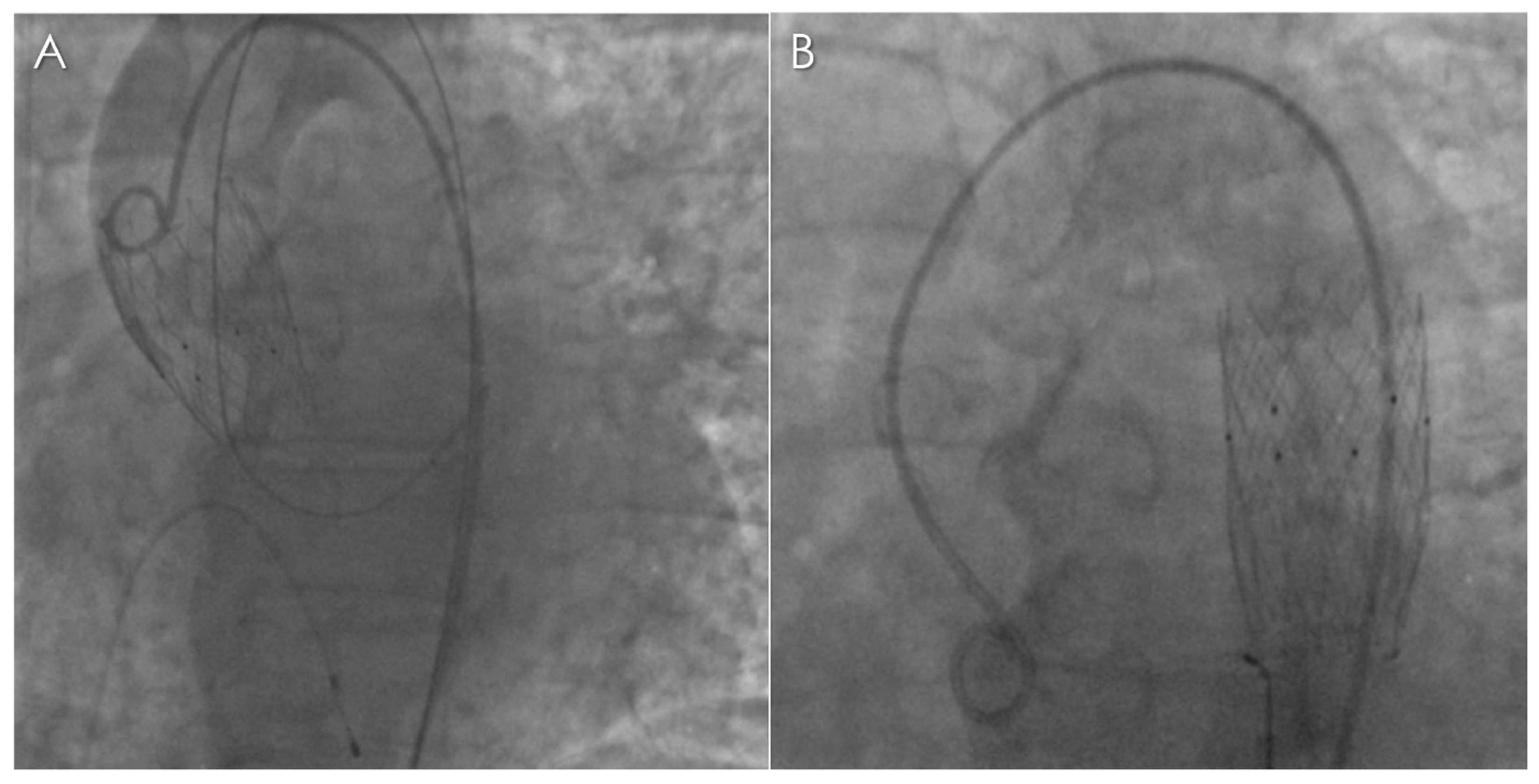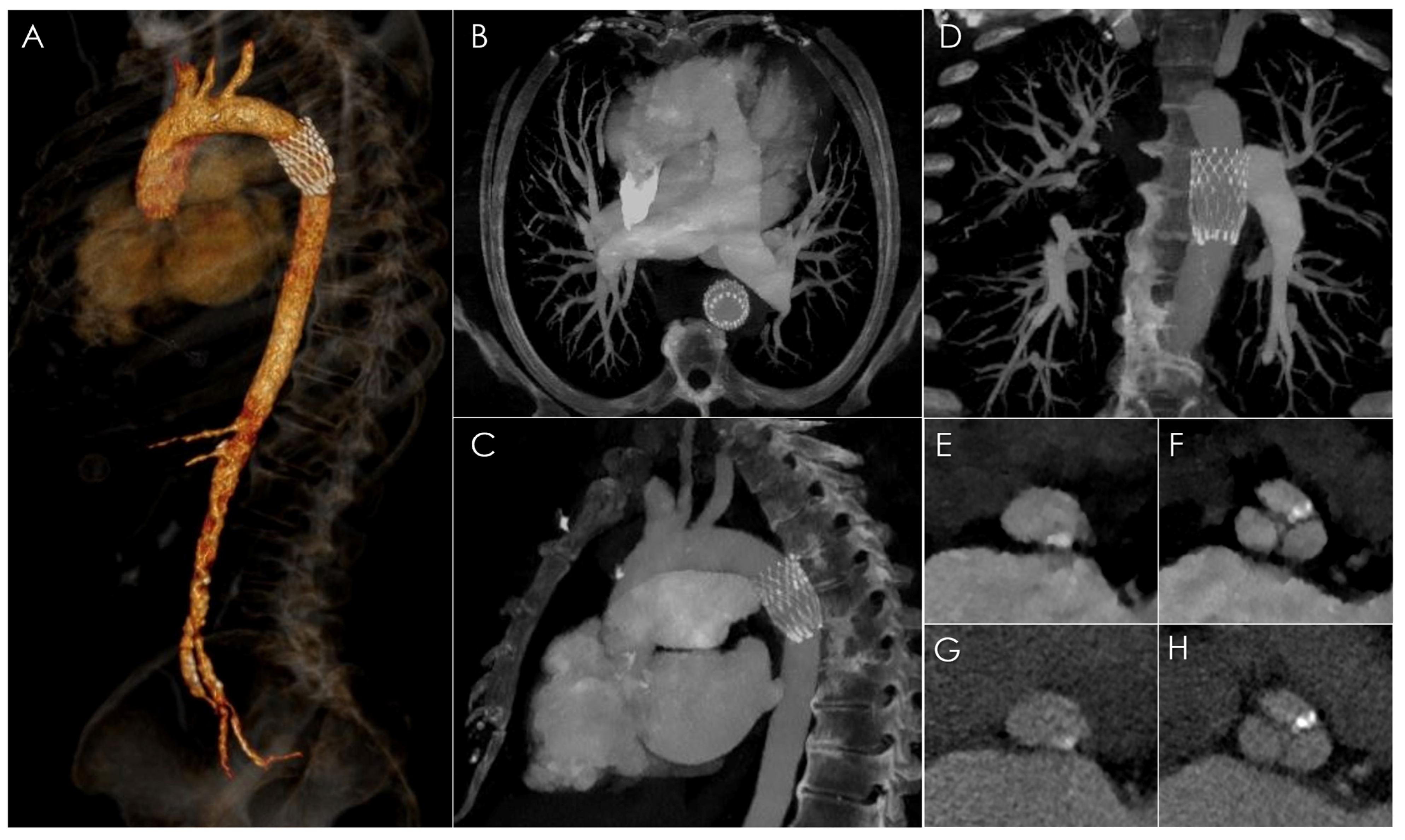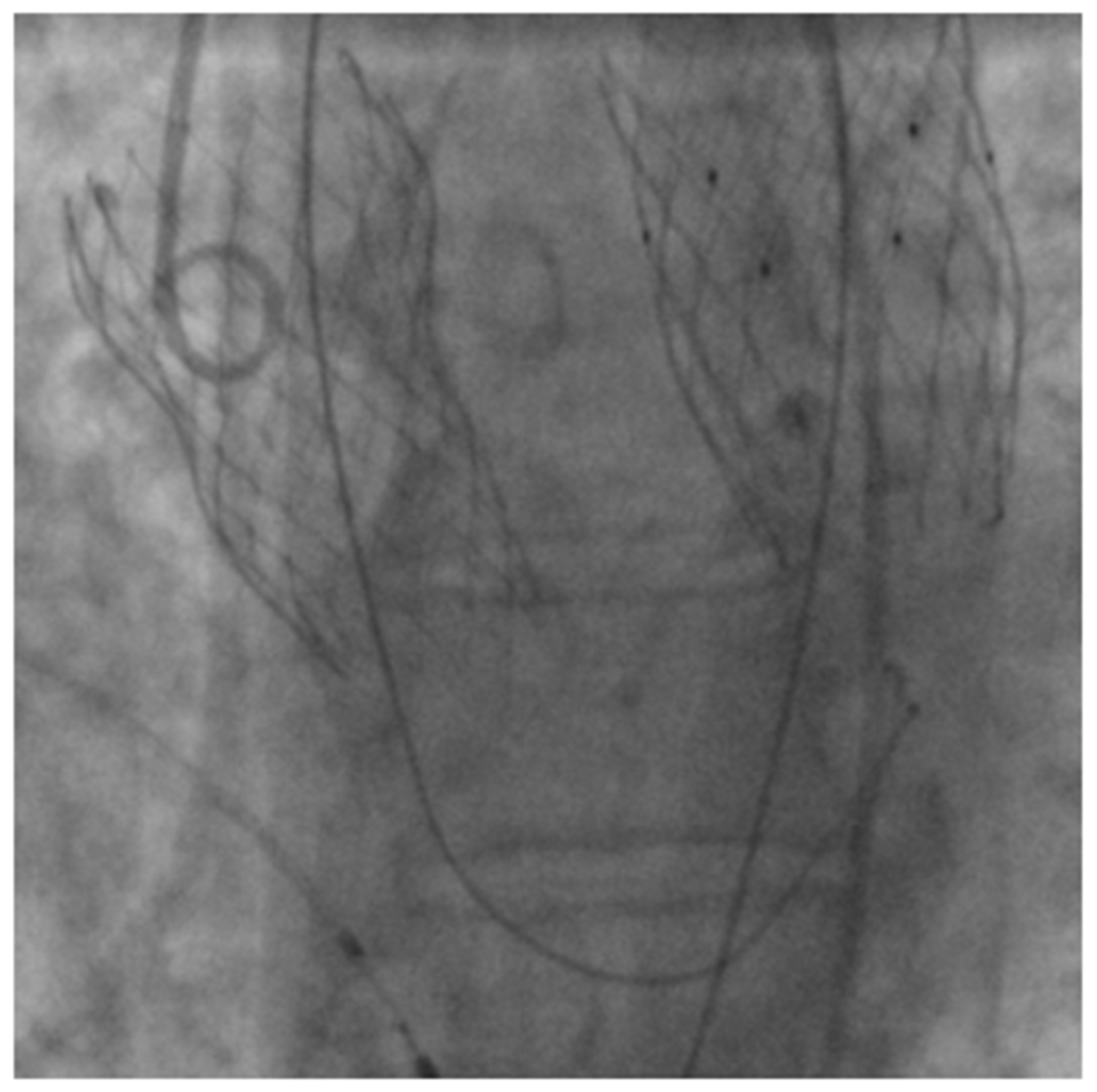Spectral CT Imaging of Prosthetic Valve Embolization after Transcatheter Aortic Valve Implantation
Abstract
:


Author Contributions
Funding
Institutional Review Board Statement
Informed Consent Statement
Data Availability Statement
Conflicts of Interest
References
- Nashef, S.A.; Roques, F.; Sharples, L.D.; Nilsson, J.; Smith, C.; Goldstone, A.R.; Lockowandt, U. EuroSCORE II. Eur. J. Cardiothorac. Surg. 2012, 41, 734–744; discussion 744-5. [Google Scholar] [CrossRef] [PubMed]
- Vahanian, A.; Beyersdorf, F.; Praz, F.; Milojevic, M.; Baldus, S.; Bauersachs, J.; Capodanno, D.; Conradi, L.; De Bonis, M.; De Paulis, R.; et al. ESC/EACTS Scientific Document Group. 2021 ESC/EACTS Guidelines for the management of valvular heart disease. Eur. Heart J. 2022, 43, 561–632. [Google Scholar] [CrossRef] [PubMed]
- Atwi, N.E.; Smith, D.L.; Flores, C.D.; Dharaiya, E.; Danrad, R.; Kambadakone, A.; Toshav, A.M. Dual-energy CT in the obese: A preliminary retrospective review to evaluate quality and feasibility of the single-source dual-detector implementation. Abdom. Radiol. 2019, 44, 783–789. [Google Scholar] [CrossRef] [PubMed]
- Cicero, G.; Ascenti, G.; Albrecht, M.H.; Blandino, A.; Cavallaro, M.; D’Angelo, T.; Carerj, M.L.; Vogl, T.J.; Mazziotti, S. Extra-abdominal dual-energy CT applications: A comprehensive overview. Radiol. Med. 2020, 125, 384–397. [Google Scholar] [CrossRef] [PubMed]
- Arendt, C.T.; Czwikla, R.; Lenga, L.; Wichmann, J.L.; Albrecht, M.H.; Booz, C.; Martin, S.S.; Leithner, D.; Tischendorf, P.; Blandino, A.; et al. Improved coronary artery contrast enhancement using noise-optimised virtual monoenergetic imaging from dual-source dual-energy computed tomography. Eur. J. Radiol. 2020, 122, 108666. [Google Scholar] [CrossRef] [PubMed]
- D’Angelo, T.; Cicero, G.; Mazziotti, S.; Ascenti, G.; Albrecht, M.H.; Martin, S.S.; Othman, A.E.; Vogl, T.J.; Wichmann, J.L. Dual energy computed tomography virtual monoenergetic imaging: Technique and clinical applications. Br. J. Radiol. 2019, 92, 20180546. [Google Scholar] [CrossRef] [PubMed]
- Leithner, D.; Mahmoudi, S.; Wichmann, J.L.; Martin, S.S.; Lenga, L.; Albrecht, M.H.; Booz, C.; Arendt, C.T.; Beeres, M.; D’Angelo, T.; et al. Evaluation of virtual monoenergetic imaging algorithms for dual-energy carotid and intracerebral CT angiography: Effects on image quality, artefacts and diagnostic performance for the detection of stenosis. Eur. J. Radiol. 2018, 99, 111–117. [Google Scholar] [CrossRef]
- Martin, S.S.; Wichmann, J.L.; Scholtz, J.E.; Leithner, D.; D’Angelo, T.; Weyer, H.; Booz, C.; Lenga, L.; Vogl, T.J.; Albrecht, M.H. Noise-Optimized Virtual Monoenergetic Dual-Energy CT Improves Diagnostic Accuracy for the Detection of Active Arterial Bleeding of the Abdomen. J. Vasc. Interv. Radiol. 2017, 28, 1257–1266. [Google Scholar] [CrossRef]
- Lenga, L.; Albrecht, M.H.; Othman, A.E.; Martin, S.S.; Leithner, D.; D’Angelo, T.; Arendt, C.; Scholtz, J.E.; De Cecco, C.N.; Schoepf, U.J.; et al. Monoenergetic Dual-energy Computed Tomographic Imaging: Cardiothoracic Applications. J. Thorac. Imaging 2017, 32, 151–158. [Google Scholar] [CrossRef] [PubMed]
Disclaimer/Publisher’s Note: The statements, opinions and data contained in all publications are solely those of the individual author(s) and contributor(s) and not of MDPI and/or the editor(s). MDPI and/or the editor(s) disclaim responsibility for any injury to people or property resulting from any ideas, methods, instructions or products referred to in the content. |
© 2023 by the authors. Licensee MDPI, Basel, Switzerland. This article is an open access article distributed under the terms and conditions of the Creative Commons Attribution (CC BY) license (https://creativecommons.org/licenses/by/4.0/).
Share and Cite
D’Angelo, T.; Vizzari, G.; Lanzafame, L.R.M.; Pergolizzi, F.; Mazziotti, S.; Gaeta, M.; Costa, F.; Di Bella, G.; Vogl, T.J.; Booz, C.; et al. Spectral CT Imaging of Prosthetic Valve Embolization after Transcatheter Aortic Valve Implantation. Diagnostics 2023, 13, 678. https://doi.org/10.3390/diagnostics13040678
D’Angelo T, Vizzari G, Lanzafame LRM, Pergolizzi F, Mazziotti S, Gaeta M, Costa F, Di Bella G, Vogl TJ, Booz C, et al. Spectral CT Imaging of Prosthetic Valve Embolization after Transcatheter Aortic Valve Implantation. Diagnostics. 2023; 13(4):678. https://doi.org/10.3390/diagnostics13040678
Chicago/Turabian StyleD’Angelo, Tommaso, Giampiero Vizzari, Ludovica R. M. Lanzafame, Federica Pergolizzi, Silvio Mazziotti, Michele Gaeta, Francesco Costa, Gianluca Di Bella, Thomas J. Vogl, Christian Booz, and et al. 2023. "Spectral CT Imaging of Prosthetic Valve Embolization after Transcatheter Aortic Valve Implantation" Diagnostics 13, no. 4: 678. https://doi.org/10.3390/diagnostics13040678
APA StyleD’Angelo, T., Vizzari, G., Lanzafame, L. R. M., Pergolizzi, F., Mazziotti, S., Gaeta, M., Costa, F., Di Bella, G., Vogl, T. J., Booz, C., Micari, A., & Blandino, A. (2023). Spectral CT Imaging of Prosthetic Valve Embolization after Transcatheter Aortic Valve Implantation. Diagnostics, 13(4), 678. https://doi.org/10.3390/diagnostics13040678





